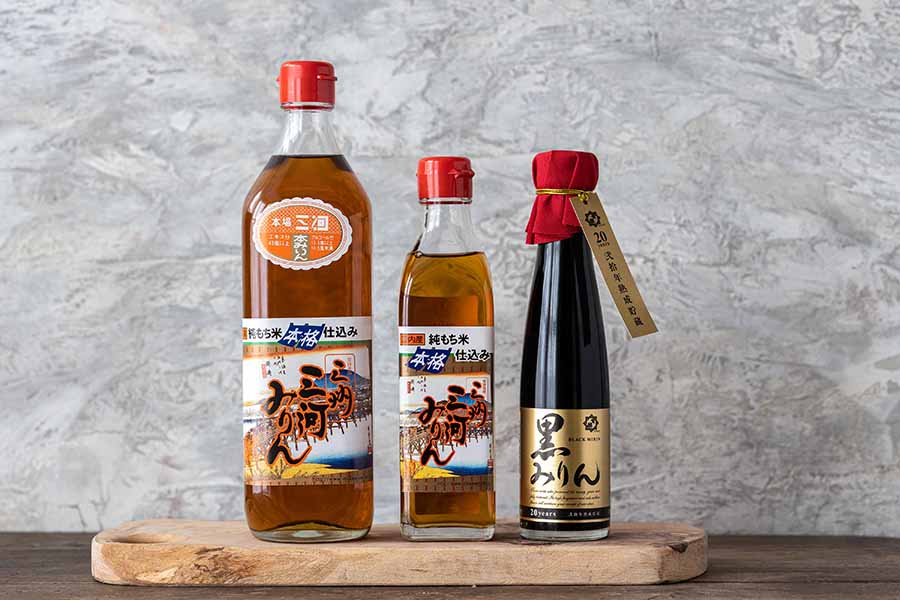
by Shirley Booth, originally written for and reproduced courtesy of The British Sake Association, www.britishsakeassociation.org/ & @brit_sake_assoc
Good water and good rice are essential for making premium sake. They are also essential to the making of mirin.
The eastern area of Aichi prefecture, known as Mikawa after the ancient name for the region, has all the right ingredients: with its mild climate and clear soft water it’s renowned for the production of mirin, which has been made here for two hundred years. It still has the largest concentration of mirin producers in Japan.
One of them is Sumiya-Bunjiro Shoten, situated in the small town of Hekinan, less than an hour’s train ride from the historical capital Kyoto, renowned for its temples and its delicate cuisine.
Sumiya-Bunjiro Shoten was established in 1910 by the great grandfather of the present Head, Toshio Sumiya, who is third generation – and passionate about the mission he has inherited.
“I will widely spread the good taste of Japanese rice through mirin, in order to contribute to the preservation and improvement of the environment.”
Thus declares Sumiya-san his core motivation and philosophy.
Sumiya-san believes that good quality ingredients come from land that is well cared for: from rice grown organically, and a natural clean water supply; and that caring for the earth and making good tasting healthy food go hand in hand.
These attitudes, born of a long and ancient tradition, are very much of today and of the future.
So, what is mirin?
Mirin was developed during the Edo period (1600-1868) as a sweet sake for drinking – so delightful that it was considered sweet and elegant enough for ‘ladies to drink’. And indeed, like a fine liqueur, real hon mirin can, and should, be drunk, in order to best appreciate its depth and complexity of flavour.
The legendary food writer Elizabeth Andoh, who has written about Japanese cuisine for five decades, tells us that the Japanese use the delightful sounding phrase “maroyaka no aji” to describe its mellow sweet flavour. Rich and sweet, but unmistakeably made from rice, it can be served as a dessert wine.
However, because in the early Edo era sugar was scarce and in spite of its deliciousness as a drink mirin, began to be used in the kitchen, and is now mostly associated with cooking Japanese foods. So – how is mirin made? And what does it do for food?
How is mirin made?
The best Japanese mirin, labelled Hon (meaning ‘real’ or ‘true’) Mirin, 本みりん, is made from almost the same ingredients as sake: rice, water and koji. The main differences are: instead of sakemai (sake rice), sweet glutinous rice (or mochi rice) is used, and shochu spirit (also made from rice – in effect distilled sake) is added to the ferment.
At Sumiya-Bunjiro Shoten, the first stage is making the shochu itself. The distillation process results in a liquid which is about 40 percent alcohol.
This shochu is then mixed with steamed sweet glutinous rice and koji-cultured rice and left to ferment for two to three months. During this time, the koji enzymes turn the starch in the rice into sugar but, because of the high alcohol content of the shochu, this sugar isn’t converted to alcohol. At the same time, the action of the koji breaks down proteins in the rice into numerous different amino acids, which creates complex rich flavours. So the mix remains very sweet, but full of umami.
At the end of the fermentation period, the mash is pressed (using the old fashioned cotton bag method). The resulting liquid – young mirin – is left to mature in large tanks for at least nine months; and the whole process often takes two years before bottling. During the maturation period the liquid darkens to a dark amber colour.
Other mirin
Unfortunately, the labelling of mirin is confusing, as you can buy a more industrially made product which is also labelled Hon Mirin (本みりん). These mirin are usually made with added sweetener in some form; and, instead of shochu distilled from rice, cheaper alcohol – made from cane sugar or other product – is used; and the entire production period is much shorter – two to three months or so. Like premium mirin they also list an alcohol content of 14% but, if you are on a budget, they can be an acceptable choice.
What is not recommended are the imitation mirin, labelled mirin-like, or mirin-fu (みりん風). These are an artificial product packed with chemicals and sweeteners. Avoid.
Colour is almost always an indication of quality, as artisan-made hon mirin, like that of Sumiya, is a sherry-like amber colour, rather than clear; and finally, price can be your guide: artisan-made hon mirin is not cheap. That’s all there is to it. Like champagne or a fine wine, you have to spend to get the best. But, as you will find, it’s worth every penny and there is no substitute for mirin.
What is mirin used for?
Enhances flavour
As in sake-making, the amino acids created during fermentation give mirin plenty of umami. As we know, umami brings out the flavour of ingredients, so mirin functions like sake, and dashi (seaweed-based stock, which is high in glutamic acid and therefore umami) to enhance the flavour of food.
Balances flavour
In traditional Japanese cooking, which is a balance between savoury and sweet, mirin sauce is used to add sweetness, and balance the saltiness of soy sauce. But it’s a delicate sweetness, composed of glucose and maltose (compared to ordinary sugar, which is fructose and glucose).
Locks in flavour
If you marinate meat or fish in mirin, the meat keeps its firmness and retains its natural juices. Marinade times are short though, as too much mirin, in vegetables especially, can toughen fibres.
Reduces odour
Like sake, mirin reduces odour: in particular it lessens fishy smells, so it’s excellent for poaching fish. It also firms up the flesh of fish, stopping it from falling apart.
Adds glaze
Mirin is an essential ingredient in tare-, the soy-flavoured basting sauce used in yakitori – and in teriyaki sauce (teriyaki meaning lustre-grilled), where it has two functions: to balance the saltiness of soy sauce, and also to add an attractive glaze or shine.
How to use mirin
• Add to dressings and dips: complements rice vinegar; complements soy sauce
• Add to simmering broths for flavouring and seasoning
• Add to marinades
Mirin as a drink
As well as using mirin in cooking, I can heartily recommend that you revive an ancient custom of treating mirin as a Japanese rice wine: like Edo period ladies did – drink it as a liqueur, in the same way you’d drink a koshu. The ricey sweetness of mirin is unique, and it pairs well with desserts; and – my favourite – it’s delicious poured over ice cream!
You can also try drinking it alongside savoury dishes, perhaps paired with rich-tasting dishes such as chicken teriyaki (made using mirin), or a miso-based dish such as nasu dengaku.
Sumiya’s website has some interesting recipe suggestions, including a mirin-based mojito cocktail, which I reproduce below. Kanpai!
 Photo courtesy of Yoko Nakado @makesmisohungry
Photo courtesy of Yoko Nakado @makesmisohungry
Recipes using mirin
DENGAKU
Dengaku is generally taken to mean a miso-based sauce, but in fact it refers to the bamboo skewers which are often used to serve pieces of tofu topped with miso dressing. The skewers are said to resemble the wooden stilts used by ‘dengaku’ performers – a type of theatrical entertainment popular in medieval times – and the name stuck. This sauce can be used to top tofu, or grilled aubergine to make nasu dengaku.
Ingredients
• 6 tbsp dark miso (Hacho or barley miso is good)
• 4 tbsp sugar
• 4 tbsp mirin
• 2 tbsp sake
Method
In a small pan combine the ingredients, and put on a medium flame. Stir until the sugar is dissolved, and all is well combined. Stir a few minutes until it slightly thickens. Take off the heat and use to slather on pieces of grilled aubergine, or thickly cut tofu, then grill a few minutes more util hot and bubbling.
TERIYAKI SAUCE
Teriyaki in fact refers not to a flavour, but to the cooking technique – ‘lustre-grilled’: where teri means lustre, or gloss, and yaki is to grill. Teriyaki sauce is so easy to make that I think it is a crime to buy any ready–made version. And if you use top class Mikawa mirin you can be sure of a sublime result.
Ingredients
• 100ml mirin
• 60ml (4 tbsp) sake
• 100ml soy sauce
• 4 tbsp sugar
• 2 tsp ginger juice, squeezed from freshly grated ginger
Method
Put the mirin and sake in a small pan and bring to a boil. Simmer for a minute or two to burn off the alcohol, then add the soy sauce, sugar and ginger juice. Bring up to the boil again. Authentic Japanese teriyaki sauce is now left to simmer for anything up to twenty minutes, until it’s reduced by about half, and slightly syrupy. Alternatively, you can thicken the sauce with a little cornflour: this means the sauce will be less intensely flavoured but, for those on a budget, it will go further! I always add ginger juice for added zing, but some people add garlic, or even chilli. Feel free to use this basic recipe as a springboard for your own taste.
Use to marinate and grill chicken, salmon, steak, lamb chops, tofu: so many foods are enhanced by a little teriyaki sauce.
MIRIN MOJITO COCKTAIL (recipe courtesy Sumiya-Bunjiro Shoten)
Ingredients
• 30ml Mikawa mirin
• 7 ice cubes
• 5ml mint syrup
• 12 mint leaves
• 120ml club soda
• wedge lime
Method
Put ice cubes into a large glass, and add the mirin and mint syrup. Bruise eight of the mint leaves to release their oil and aroma, and add to the glass. Top up with the soda; stir. Garnish with the remaining mint leaves and a wedge of lime.
© Shirley Booth 2021



